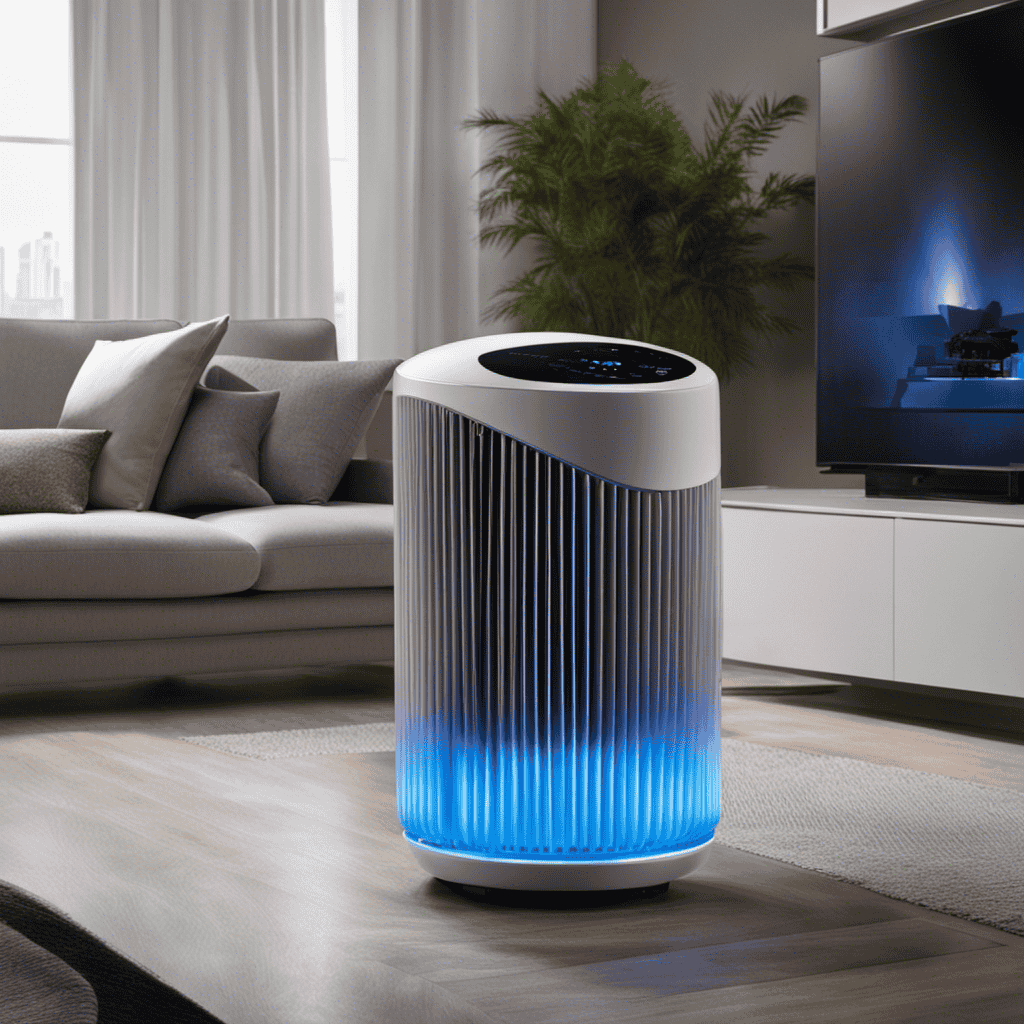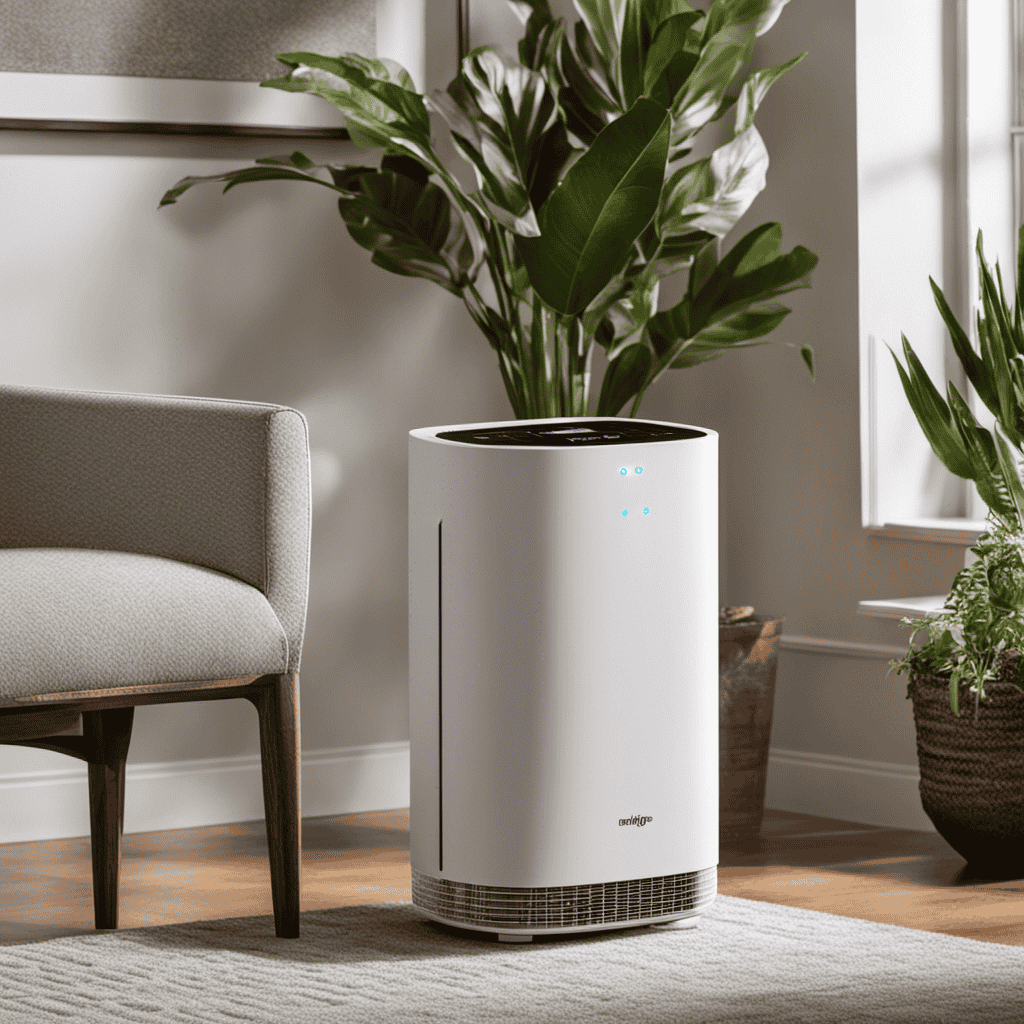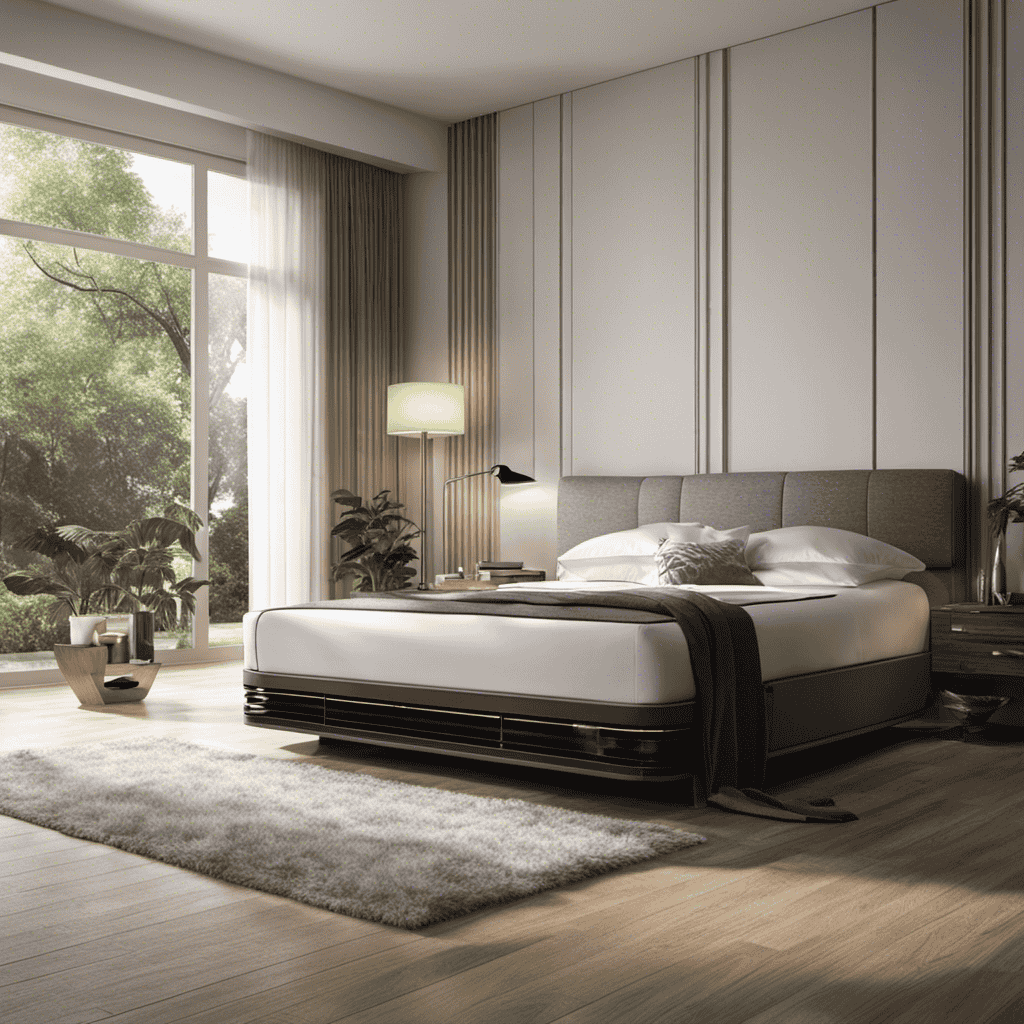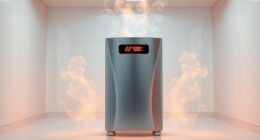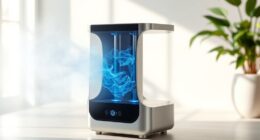Have you ever been curious about the functionality of the ‘ion’ button on your air purifier? Allow me to clarify its purpose.
You see, air purifiers are like superheroes, fighting against the invisible villains lurking in our indoor air. And the ion button? It’s like their secret weapon, unleashing a powerful force called ionization.
In this article, we’ll delve into the world of ions and explore how they work their magic to purify the air in your home. Get ready to breathe a sigh of relief as we uncover the wonders of the ion button on your air purifier.
Key Takeaways
- The ion button on an air purifier releases negative ions into the air, which attach to airborne particles like dust, pollen, and pet dander.
- The attachment of negative ions makes the particles heavier, causing them to fall to the ground or surfaces, reducing the number of pollutants in the air.
- Using the ion button in conjunction with filters provides optimal results in improving air quality.
- Regularly cleaning the ionization plates or filters ensures the proper functioning of the ion button.
How Does the Ion Button Work
To understand how the ion button works on your air purifier, you simply need to press it and it will release negative ions into the air.
These negative ions are beneficial for improving air quality in your home. When released, they attach themselves to airborne particles, such as dust, pollen, and pet dander, making them heavier and causing them to fall to the ground or onto surfaces.
This helps to reduce the number of pollutants in the air and can provide relief for those who suffer from allergies or respiratory conditions.
However, it is important to note that there are potential risks associated with ionization technology. Some studies have suggested that high levels of negative ions can produce harmful byproducts such as ozone.
Therefore, it is crucial to use ionization technology in moderation and ensure proper ventilation in the room.
Understanding the benefits and risks of ionization technology is essential for making informed decisions about air purification in your home.
Understanding Ionization Technology
Understanding how ionization technology works can help improve the air quality in your home. Ionization technology works by emitting negatively charged ions into the air, which attach themselves to positively charged particles such as dust, pollen, and mold spores. This process causes these particles to become heavier and fall out of the air, effectively reducing their presence in the environment.
To ensure safety while using the ion button on your air purifier, it is important to follow the manufacturer’s instructions and guidelines. Regular maintenance is also necessary to keep the ionization technology functioning properly. This includes cleaning the ionization plates or filters regularly to remove any accumulated particles and ensuring that the ionization button is not damaged or malfunctioning.
Taking these steps will help ensure the efficient and safe operation of your air purifier.
Benefits of Using the Ion Button
Using ionization technology in your home can improve air quality by reducing the presence of dust, pollen, and mold spores. The ion button on your air purifier is designed to release negatively charged ions into the air. These ions attach themselves to airborne particles, causing them to become heavy and fall to the ground or be easily captured by the air purifier’s filters.
This process, known as ionization, helps to remove harmful pollutants from the air you breathe. However, it is important to be aware of the potential risks associated with ionization technology. Some studies suggest that high levels of negatively charged ions can produce harmful byproducts, such as ozone.
It is recommended to follow the manufacturer’s instructions and use the ion button sparingly to minimize any potential risks.
The Role of Ions in Air Purification
The release of negatively charged ions into the air can help improve the effectiveness of an air purifier. When the ion button is activated, it releases ions that attach themselves to airborne particles. These charged particles then become heavier and are more easily captured by the purifier’s filters.
To maximize the effectiveness of the ion button, follow these usage guidelines:
- Use the ion button in conjunction with the air purifier’s filters for optimal results.
- Keep the ion button on for a few hours each day to continuously improve air quality.
- Avoid using the ion button in rooms with sensitive electronic devices, as ions can potentially interfere with their operation.
- Clean the ionizing plates regularly to ensure the ion button functions properly.
Ionization Vs. Filtration: What’s the Difference
When it comes to improving air quality, ionization and filtration have distinct differences you should be aware of.
Ionization refers to the process of generating negative ions that attach themselves to airborne particles, causing them to become heavy and fall out of the air. This technology is often used in air purifiers and HVAC systems to remove pollutants and allergens from the air.
On the other hand, filtration involves the use of physical filters to capture and remove particles from the air. This method is effective in trapping larger particles but may not be as effective in removing smaller ones.
It is important to note that while ionization can be effective in improving air quality, it should not be used as a substitute for filtration. In fact, combining ionization with UV C technology can enhance the purification process by killing bacteria and viruses.
Now, let’s explore when to use the ion button for optimal air purification.
When to Use the Ion Button
To optimize your air purification, you’ll want to consider the best time to engage the ion feature. The ion button on your air purifier can be a powerful tool in improving air quality, but it’s important to use it wisely. Here are a few key points to keep in mind:
-
Turn on the ion button when you’re not in the room: The ionization process can produce a small amount of ozone, which can be irritating to some individuals. To minimize exposure, it’s best to activate the ion feature when you’re not present in the room.
-
Use the ion button in conjunction with filtration: While ionization can help remove airborne particles, it’s most effective when combined with a high-quality filtration system. By using both features together, you can maximize the efficiency of your air purifier.
-
Consider the size of your space: The effectiveness of the ion button can vary depending on the size of the room. For larger areas, you may need to adjust the settings or use multiple air purifiers to ensure optimal air purification.
-
Regularly clean the ionization plates: Over time, the ionization plates in your air purifier can become dirty or covered in residue. It’s important to clean them regularly to maintain the efficiency and effectiveness of the ion feature.
By following these guidelines, you can make the most of the ion button on your air purifier and improve the air quality in your home or office.
Now, let’s address some common misconceptions about ionization.
Common Misconceptions About Ionization
One common misconception about ionization is that it solely removes odors from the air. While it is true that ionization technology can help eliminate unpleasant smells, its benefits go beyond just odor removal.
Air purifiers with ionization technology work by releasing negatively charged ions into the air. These ions attach themselves to airborne particles, such as dust, pollen, and pet dander, causing them to become heavier and fall to the ground or be trapped by the air purifier’s filters.
This process effectively reduces the number of airborne allergens and pollutants, improving the overall air quality in your home. It is important to note that ionization technology should not be relied upon as the sole method of air purification, but rather used in conjunction with other filtration methods for optimal results.
Potential Health Effects of Ionization
When it comes to ionization and allergies, there is a lot of debate and confusion. Many people believe that ionizers can help alleviate allergy symptoms by removing allergens from the air. However, there is limited scientific evidence to support this claim.
Furthermore, some studies have even suggested that ionizers may actually worsen respiratory health by producing harmful byproducts.
Ionization and Allergies
Have you tried using the ion button on your air purifier to alleviate allergies?
Ionization is a powerful tool in improving indoor air quality and reducing asthma triggers. When the ion button is activated, the air purifier releases negatively charged ions into the air. These ions attach themselves to positively charged particles such as dust, pollen, and pet dander.
The ionized particles become heavy and fall to the ground or are easily captured by the air purifier’s filters. This process effectively removes allergens from the air, providing relief for allergy sufferers.
Additionally, ionization can help eliminate airborne bacteria and viruses, further enhancing the overall air quality in your home.
Ionizers and Respiratory Health?
Using an ionizer can improve respiratory health by reducing airborne allergens and enhancing indoor air quality. Ionizers work by releasing negative ions into the air, which attach to positively charged particles like dust, pollen, and pet dander. This process causes these particles to become heavy and fall out of the air, reducing the number of allergens that can be inhaled.
Additionally, ionization can help to neutralize harmful pollutants and odors, further improving the overall air quality in your home. This is particularly beneficial for individuals with respiratory conditions such as asthma or allergies, as it can help to alleviate symptoms and create a healthier environment.
It’s important to note that ionizers should be used in conjunction with other air purification methods for the best results in maintaining indoor air quality.
How the Ion Button Affects Air Quality
The ion button on your air purifier can greatly improve air quality by releasing negative ions into the air. These negative ions help to neutralize and eliminate harmful pollutants, such as dust, allergens, and smoke particles. Here are four key benefits of using the ion button on your air purifier:
- Reduction of airborne bacteria and viruses.
- Elimination of unpleasant odors.
- Increased overall freshness of the air.
- Improved respiratory health.
To maximize the effectiveness of the ion button, here are a few usage tips:
- Keep the ion button on continuously for optimal purification.
- Place the air purifier in a central location for better air circulation.
- Change the filters regularly to maintain peak performance.
- Clean the ionizing wires or plates periodically to ensure proper ionization.
Tips for Maximizing the Effectiveness of the Ion Button
The ion button on your air purifier offers several benefits that can enhance the overall air quality in your space.
By releasing negatively charged ions, it helps to neutralize harmful pollutants such as dust, pollen, and pet dander, making the air cleaner and healthier to breathe.
However, it is important to exercise caution when using the ion button, as excessive ionization can potentially produce harmful ozone levels, especially in enclosed spaces.
Ion Button Benefits
Did you know that the ion button on your air purifier can help improve the air quality in your home? The ion button features advanced technology that releases negatively charged ions into the air.
These ions attach to positively charged particles like dust, pollen, and pet dander, causing them to become heavy and fall to the ground. This process effectively removes these particles from the air, reducing allergens and improving air quality.
To ensure the ion button continues to work optimally, regular maintenance is essential. It is recommended to clean the ionization plates every few weeks to remove any buildup of particles. Additionally, replacing the ionization plates annually will help maintain the effectiveness of the ion button.
By regularly utilizing and maintaining the ion button, you can enjoy cleaner and healthier air in your home.
In the next section, we will discuss important precautions to keep in mind when using the ion button on your air purifier.
Ion Button Precautions
When using the ion button, it’s important to be mindful of potential safety hazards.
While the ion button on your air purifier can provide several benefits, it also requires proper maintenance and precautions. Regular cleaning of the ionization plates is necessary to ensure optimal performance and prevent the accumulation of dust or debris.
Additionally, it is important to follow the manufacturer’s instructions to avoid overexposure to ions, which can potentially irritate the respiratory system. If you have concerns about the ion button or prefer not to use it, there are alternative air purifiers available that do not utilize ionization technology.
Understanding the precautions and alternatives associated with the ion button is crucial for maintaining a safe and effective air purifier.
Now, let’s delve into the science behind ionization.
The Science Behind Ionization
Let’s explore the science behind ionization and how it affects the air quality in your home.
Ionization is a process that uses electrically charged particles, called ions, to remove indoor pollutants from the air. When ionization occurs, these ions attach themselves to harmful particles such as dust, pollen, and pet dander, causing them to become heavy and fall to the ground. This helps to reduce the number of airborne pollutants in your home.
Here are four key ways in which ionization improves air quality:
- Ionization neutralizes odors by breaking down volatile organic compounds.
- It reduces the presence of allergens in the air, providing relief for those with allergies or asthma.
- Ionization can help eliminate bacteria and viruses, creating a healthier environment.
- It can also help to remove smoke and other irritants from the air, improving overall indoor air quality.
Ionization and Allergen Reduction
To reduce allergens in your home, ionization helps by attaching ions to harmful particles, causing them to become heavy and fall to the ground.
Ionization is a process that improves air quality by neutralizing indoor pollutants. When the ion button on your air purifier is activated, it emits negatively charged ions into the air.
These ions then attach themselves to positively charged particles such as dust, pollen, and pet dander. The newly formed heavier particles are no longer able to float freely in the air and instead settle on surfaces like the floor or furniture.
This process effectively reduces the number of allergens in the air, improving the overall air quality in your home. Remember, regular cleaning of these surfaces is still necessary to completely remove the trapped allergens.
Ionization and Odor Elimination
As we continue our discussion on the benefits of ionization, it is important to also address the potential health concerns associated with this technology.
Ionization has been shown to have several benefits, such as improving air quality by reducing allergens and eliminating odors.
However, there are also concerns regarding the production of ozone and the potential for respiratory irritation.
Benefits of Ionization
The ion button on your air purifier helps to improve air quality by releasing negative ions into the air. Ionization is a powerful tool in the fight against indoor pollutants, as it can effectively remove harmful particles from the air.
Here are four benefits of using the ionization feature on your air purifier:
-
Reduction of airborne allergens: Negative ions attach themselves to allergens like pollen, dust, and pet dander, causing them to become heavier and fall to the ground.
-
Elimination of odors: Ionization can neutralize unpleasant odors by binding to the odor-causing molecules and rendering them harmless.
-
Refreshing the air: Negative ions can help break down and remove airborne pollutants, leaving the air feeling cleaner and fresher.
-
Enhanced air quality: By removing pollutants and allergens, ionization helps to create a healthier indoor environment and improve overall air quality.
With these benefits in mind, it’s important to consider potential health concerns associated with ionization.
Health Concerns With Ionization
If you’re concerned about potential health risks, it’s important to be aware of the possible effects of ionization. Ionization is a process used in air purifiers to remove pollutants from indoor air. While it can be effective in improving indoor air quality, there are also potential risks associated with ionization. These risks include the production of ozone, which can irritate the respiratory system and worsen existing respiratory conditions. Additionally, some studies have suggested a link between ionization and the production of harmful byproducts, such as formaldehyde. To understand the potential ionization risks and make an informed decision, it is crucial to consider the specific features and specifications of the air purifier. Here is a table highlighting some potential risks and considerations associated with ionization and indoor air quality:
| Potential Risks | Considerations | Recommendations |
|---|---|---|
| Ozone production | Check ozone emission levels | Opt for air purifiers with low ozone levels |
| Byproduct emissions | Research specific brand/models | Choose air purifiers with low emissions |
| Respiratory issues | Monitor any symptoms | Consult a healthcare professional if needed |
Ionization and Bacterial/Viral Contaminant Removal
Ionization is an effective method for removing bacterial and viral contaminants from the air. When the air purifier’s ionization feature is activated, it releases negative ions into the air. These ions attach themselves to the airborne contaminants, causing them to become heavy and fall out of the air. This process effectively removes harmful bacteria and viruses from the indoor environment.
Here are four key benefits of ionization for indoor air quality:
- Reduction of bacteria and viruses: Ionization helps to eliminate harmful pathogens, reducing the risk of respiratory infections and illnesses.
- Improved overall air quality: By removing bacterial and viral contaminants, ionization helps to create a cleaner and healthier indoor environment.
- Odor elimination: Ionization can also help to neutralize unpleasant odors caused by bacteria and viruses.
- Mold spore removal: In addition to bacteria and viruses, ionization can also help to reduce the presence of mold spores in the air, improving air quality for individuals with respiratory conditions.
Ionization and Dust/Pollen Reduction
When activated, the ionization feature releases negative ions into the air, attaching themselves to dust and pollen particles, effectively reducing their presence. Understanding the ionization process and its impact on indoor air quality is crucial for anyone using an air purifier.
Ionization works by emitting negative ions that are attracted to positively charged particles in the air, such as dust and pollen. Once the negative ions attach themselves to these particles, they become heavier and are no longer able to float freely in the air. This leads to a significant reduction in the amount of dust and pollen circulating indoors.
Frequently Asked Questions
Can the Ion Button on My Air Purifier Be Harmful to My Health?
The ion button on my air purifier can potentially have harmful effects on my health. The ionization process releases charged particles into the air, which can cause respiratory issues and other health problems.
Will Using the Ion Button on My Air Purifier Eliminate All Odors in My Home?
Using the ion button on my air purifier can help eliminate some odors in my home. However, it’s important to note that regular air purifier maintenance and proper use are also crucial for the best results.
Can Ionization Technology in Air Purifiers Remove Bacteria and Viruses From the Air?
Ionization technology in air purifiers can effectively remove bacteria and viruses from the air. Compared to other air purification methods, the benefits of ionization technology include its ability to neutralize harmful particles and improve overall air quality.
How Effective Is the Ion Button in Reducing Dust and Pollen in My Home?
Pressing the ion button on my air purifier is like opening a window to let in a fresh breeze. It reduces dust and pollen, keeping my home cleaner and healthier. Regular maintenance and choosing the right air purifier are key.
Are There Any Potential Side Effects of Using the Ion Button on My Air Purifier?
There may be potential risks associated with using the ion button on your air purifier. It is important to consider any long-term effects it may have on your health before making a decision.
Conclusion
After learning about the ion button on my air purifier, I am truly amazed at the power it holds. It’s like a superhero, swooping in to save the day and protect me from all the invisible threats in the air.
With its ionization technology, it not only filters out allergens, but also eliminates odors and removes harmful bacteria and viruses. It’s a force to be reckoned with, ensuring that the air I breathe is pure and clean.
I feel a sense of security knowing that my air purifier is equipped with this incredible ion button.

